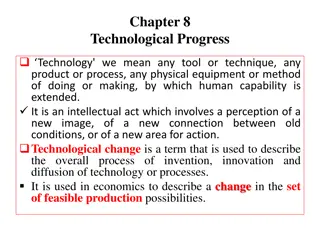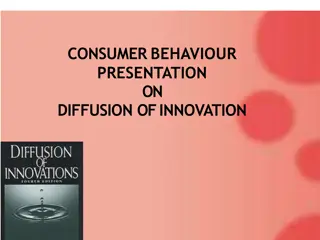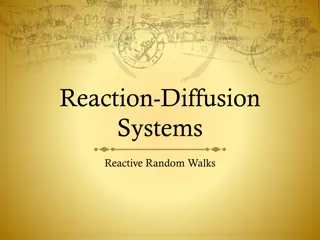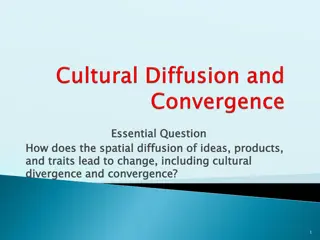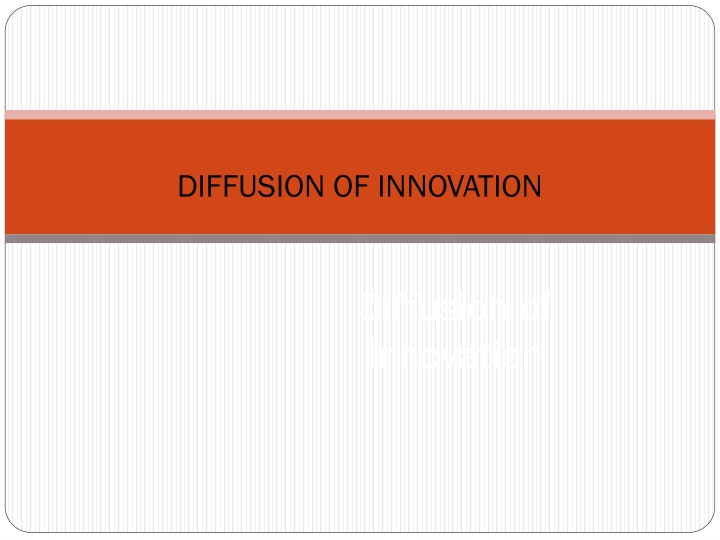
Diffusion of Innovation in Markets
Explore the concept of diffusion of innovation in markets, including the challenges faced by new products, reasons for success or failure, and the importance of creating a value chain to gain a competitive edge. Learn about innovation, new product development, and the process of how ideas spread within a social system. Gain insights into maximizing market potential and achieving long-term profitability.
Download Presentation

Please find below an Image/Link to download the presentation.
The content on the website is provided AS IS for your information and personal use only. It may not be sold, licensed, or shared on other websites without obtaining consent from the author. If you encounter any issues during the download, it is possible that the publisher has removed the file from their server.
You are allowed to download the files provided on this website for personal or commercial use, subject to the condition that they are used lawfully. All files are the property of their respective owners.
The content on the website is provided AS IS for your information and personal use only. It may not be sold, licensed, or shared on other websites without obtaining consent from the author.
E N D
Presentation Transcript
DIFFUSION OF INNOVATION Diffusion of Innovation
New Products in the Market New Products in the Market NEW PRODUCTS IN THE MARKET Every year around 5000 new products appear in the market. However, most fail and only a few remain ( around 20%). Products which are innovative.
Why does this Happen? Macromarketing issues: Valuable resources are wasted which might have been deployed towards more productive uses Products that might have helped people do things more productively or attain higher levels in their quality of life, fail to be used Successful products are those that become culturally anchored.
Why does this Happen? (Contd.) Micromarketing issues: Succesful new product development is an important element in achieving long term competitive superiority and profitability, especially in low growth markets New product development plays an important role in market leadership and profitability. Market leaders normally have three times higher returns than firms with lower market shares A successful new product can be the beginning of a whole new company
The Value Chain Contemporary firms are being attacked by competitively on every dimension and from every direction. The only way to survive this onslaught is to create a valuechain to serve the customer, which will serve to differentiate the successful firm from its competitors and will provide competitive superiority on the critical attributes of importance to the consumer
What Is An Innovation? It is any idea or product perceived by the potential adopter to be new. New products are ideas, behaviour or things that are qualitatively different from existing forms
Diffusion of Innovation A process by which a new product moves from initial introduction to regular purchase and use A process by which an innovation (idea) is communicated through certain channels over time among the members of a social system Everett Rogers
Diffusion Variables Innovation Communication Time Social system
Types of Innovations Modification or improvement of an existing product Continuous May involve the creation of either a new product or the alteration of an existing one ,but does not generally alter established patterns of customer buying and product use Dynamically Continuous Production of an entirely new product that causes customers to alter their behaviour patterns significantly Discontinuous
Innovations include both a hardware and a software component The hardware are the physical and tangible aspects of a product. The software is the understanding consumers values and lifestyles
Likelihood of Innovation Success New products that are most likely to succeed are those that appeal to strongly felt needs Relative advantage Degree to which the product is consistent with existing values and past experience of the adopters Compatibility Degree to which an innovation is perceived as difficult to understand and use Complexity The ability to make trials easy for new products without economic risk to the consumer Trialability Reflects the degree to which results from using a new product are visible to friends and neighbours Observability
Types of Innovators Cognitive Sensory Monomorphic Polymorphic Problem Solving, Cerebral, New Mental Experience Fantasy, Day Dreaming, Hedonistic, Thrill Seeking Consumers Who Are Innovators For One Type Of Product Consumers Who Are Innovators For More Than One Type Of Product
Characteristics That Encourage Rejection Value Barrier Usage Barrier Risk Barrier
Speed of Diffusion Competitive Intensity Reputation Of The Supplier Standardised Technology Vertical Coordination Resource Commitments
Communication of New Products Mass media WOM Homophily Degree to which pairs of individuals who interact are similar in beliefs, education and social status Heterophily Inconsistent with own beliefs and views
The Adoption Decision Process Everett Rogers Knowledge Persuasion Decision Implementation Confirmation
Adopter Classes Innovators - 2.5% Laggards 16% Late Early adopters 13.5% majority 34% Early majority 34%
Innovativeness This is the degree to which an individual adopts an innovation relatively earlier than others Based on time of adoption Based on number of new product adoption
Parameters for Innovativeness Personality and attitude
Socio Economic Variables Education Literacy Higher social status Upward social mobility Larger-sized units Commercial orientation Favourable attitude towards credit Specialized operations
Personality and Attitude Ability to cope with uncertainty Favourable attitude towards education Favourable attitude towards science High aspirations Empathy Ability to deal in abstraction Rationality Intelligence Favourable attitude towards change
Communication Variables Social participation Interconnectedness with the social system Cosmopoliteness Change agent contact Mass media exposure Exposure to interpersonal communication channels Knowledge of innovations Opinion leadership Belonging to highly interconnected systems





